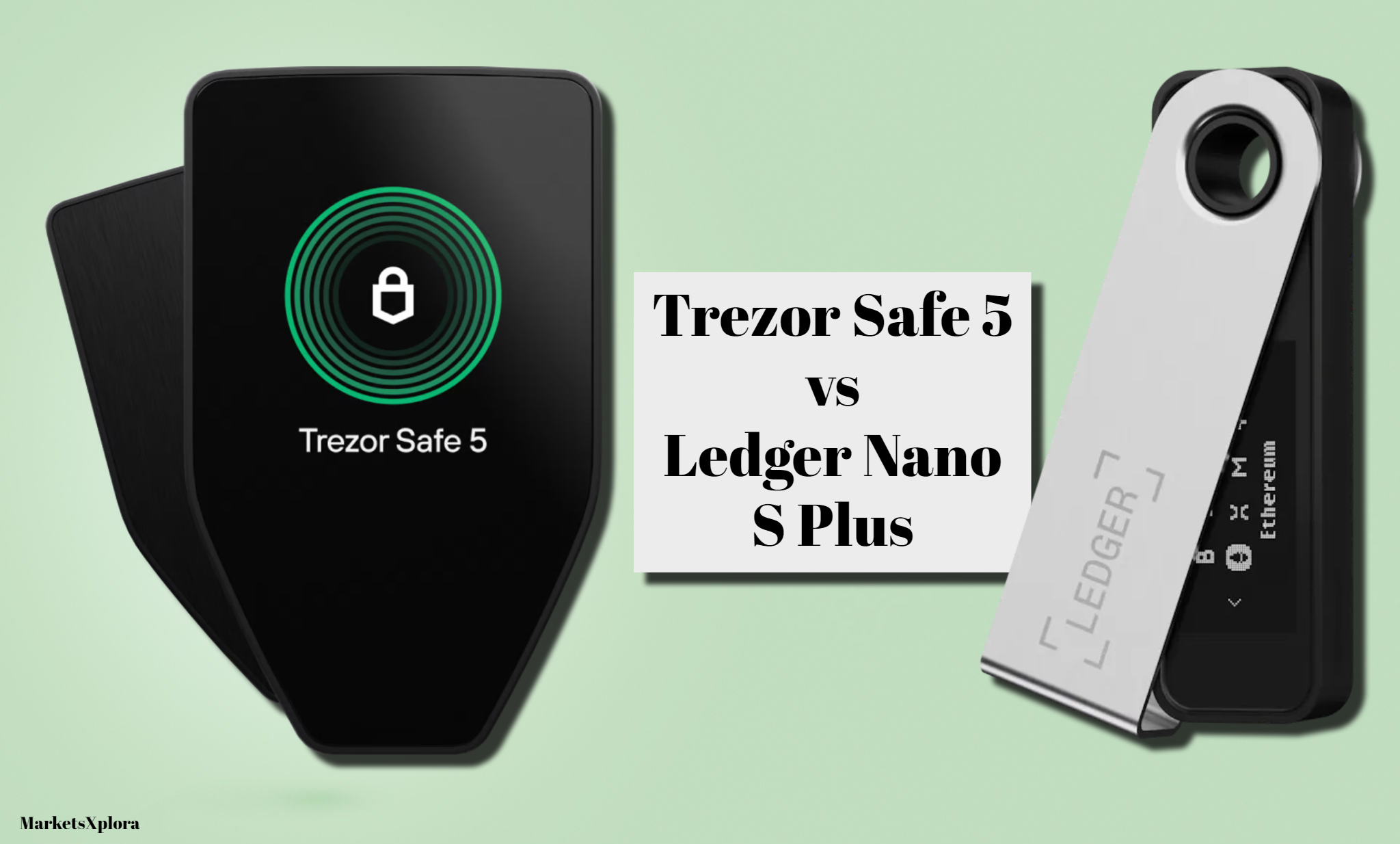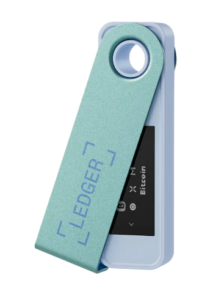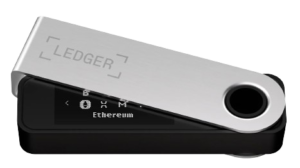
Are you trying to decide between the new Trezor Safe 5 vs the Ledger Nano S Plus? Don’t worry, I’ve got your back. Picking the right hardware wallet can be tricky, but I’m here to make it easy for you.
In this comparison of Safe 5 vs Nano S Plus, we’ll help you’ll decide exactly which wallet is the best fit for you. Ready to find your perfect Bitcoin wallet? Let’s jump in!
Trezor Safe 5 vs Ledger Nano S Plus: Overview
Feature |
||
|---|---|---|
Launch Year |
2024 |
2022 |
Price |
$169 |
$79 |
Screen |
Vibrant color touchscreen |
Larger screen (non-touch) |
Navigation |
Touchscreen |
Buttons |
Haptic Feedback |
Yes |
No |
Cryptocurrencies |
Over 9,000 |
Over 5,500 |
Simultaneous Apps |
Not specified |
Up to 100 |
Backup Standard |
12-, 20-, 24-word |
24-word |
Secure Element |
NDA-free EAL 6+ |
Certified CC EAL6+ |
MicroSD Slot |
Yes |
No |
NFT Support |
No |
Yes |
Companion Software |
Trezor Suite |
Ledger Live |
Design and Build
Physical dimensions and weight
- Trezor Safe 5: 65.9 x 40 x 8 mm, weighing 23g
- Ledger Nano S Plus: 62.39 x 17.40 x 8.24 mm, weighing 21g
The Trezor is slightly larger and heavier, but both are compact and lightweight.
Screen size and type Trezor
- Safe 5: 1.54″ color touchscreen with 240 x 240 pixel resolution
- Ledger Nano S Plus: 128 x 64 pixel, but not a touchscreen
The Trezor offers a more modern, smartphone-like interface with its touchscreen.
Connectivity
- Both Trezor Safe 5 and Ledger Nano S Plus use USB-C connections for charging and connecting to computers.
Build materials
- Trezor Safe 5: PMMA plastic with anodized aluminum backplates, Gorilla Glass 3
- Ledger Nano S Plus: Brushed stainless steel and plastic
Both use durable materials, with Trezor emphasizing scratch resistance.
Color options
- Trezor Safe 5: Black Graphite, Violet Ore, Green Beryl
- Ledger Nano S Plus: Matte Black, Pastel Green, Amethyst Purple, Retro Gaming, BTC Orange
Ledger offers more color choices for personalization.
Durability and travel-friendliness
Both wallets are designed for durability and travel. The Trezor Safe 5 is explicitly stated as X-ray safe and suitable for air travel. While not specifically mentioned for the Ledger, hardware wallets are generally travel-friendly. The Trezor’s Gorilla Glass may offer additional scratch protection, but the Ledger’s stainless steel casing could provide better overall durability.
User Interface and Experience
Screen navigation (touchscreen vs buttons)
Trezor Safe 5: Features a full color touchscreen, allowing for smartphone-like navigation. I can swipe, tap, and scroll directly on the screen to interact with the device.
Ledger Nano S Plus: Uses a two-button navigation system. I need to press the buttons to scroll through options and confirm actions, which might feel less intuitive at first but can be mastered quickly.
Ease of use for beginners
Trezor Safe 5: The touchscreen interface is likely more familiar to most users, potentially making it easier for beginners to adapt. The larger, color display allows for clearer instructions and visual cues.
Ledger Nano S Plus: While the button navigation might have a slight learning curve, the simpler interface could be less overwhelming for some beginners. The larger screen (compared to the original Nano S) improves readability and navigation.
Additional features
Trezor Safe 5:
- Haptic feedback through the Trezor Touch engine, providing tactile responses to my actions.
- MicroSD card slot for potential future features or firmware updates.
Ledger Nano S Plus:
- No additional UI features.
Security Features
Secure element specifications
Trezor Safe 5: Uses an NDA-free EAL 6+ Secure Element chip.
Ledger Nano S Plus: Employs a CC EAL6+ certified ST33K1M5 chip.
Both devices use high-grade secure elements, with Trezor emphasizing its NDA-free nature for added transparency.
Open-source vs closed-source
Trezor Safe 5: Proudly open-source, allowing for community review and audits of the code.
Ledger Nano S Plus: Uses a proprietary, closed-source secure element, but much of their other code is open-source.
The open-source nature of Trezor may appeal to those who prioritize transparency and community-driven security.
PIN and passphrase protection
Both wallets offer PIN protection to secure access to the device.
Trezor Safe 5: Offers both PIN and passphrase protection, with on-device entry for added security.
Ledger Nano S Plus: Also provides PIN and optional passphrase protection.
Backup and recovery options
Trezor Safe 5:
- Offers 12-, 20-, and 24-word wallet backup options.
- Introduces an Advanced Multi-share Backup for enhanced security.
- Comes with 2x 20-word backup cards in the box.
Ledger Nano S Plus:
- Uses the standard 24-word recovery phrase.
- Includes 3 recovery sheets in the box.
Trezor offers more flexibility in backup word count and introduces a multi-share backup system, which might appeal to users wanting additional recovery options.






